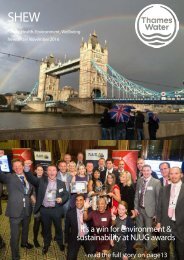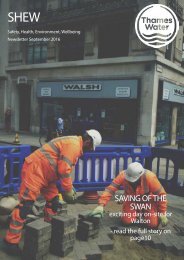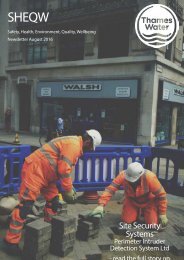SHEQWs Newsletter August
You also want an ePaper? Increase the reach of your titles
YUMPU automatically turns print PDFs into web optimized ePapers that Google loves.
In the spotlight<br />
Ecologists go surveying for Great Crested Newts<br />
SMB ecologists Gareth<br />
Lavery and David<br />
Macknay have been<br />
especially busy over the<br />
spring survey window<br />
undertaking newt surveys<br />
in potential breeding<br />
ponds and ditches, in<br />
order to inform design<br />
and/ or apply for a licence<br />
on various projects.<br />
Results of this year’s<br />
surveys: locations with GCN<br />
presence<br />
• D339 Newbury STW<br />
• D339 Carterton STW<br />
• D339 Moreton-in-Marsh STW<br />
• C946 Faringdon to Blunsdon<br />
pipeline<br />
• D018 Goose Green<br />
• D332 Stewkley STW.<br />
How to identify the<br />
presence of Great Crested<br />
Newts (GCN)<br />
Four surveys are required to<br />
determine the absence of GCN, with<br />
at least 3 of the 4 survey methods<br />
being utilised. These are;<br />
• Bottle Trap - placing traps in the<br />
pond and leaving overnight<br />
• Torching – searching for GCN at<br />
night via torchlight<br />
• Egg Search – searching leaves for<br />
signs of eggs<br />
• Netting – net used to search<br />
perimeter of pond<br />
If whilst undertaking these four<br />
surveys GCN are discovered, the<br />
survey number increase to six, in<br />
order to get a population count. This<br />
is normally 6 bottle tap and torch<br />
surveys.<br />
New Technology - EDNA<br />
eDNA water samples identifies GCN<br />
DNA. This year 73 eDNA kits were<br />
used on 22 upcoming project sites.<br />
The benefits of this new<br />
technique are:<br />
Major cost reduction over the AMP<br />
(estimated at c. £500,000)<br />
Reduced health and safety risk to<br />
personnel as less night-time work in,<br />
and next to, water<br />
Early identification which helps<br />
reduce programme delays,<br />
aid Project Managers and helps<br />
understand potential impact on<br />
VOWD (Value of Work Delivered)<br />
What happens if GCN<br />
presence is confirmed?<br />
If identified during design, the<br />
environmental team will work with<br />
the design team to attempt to<br />
“design out” the issue by locating<br />
new works to avoid their habitat<br />
(scrub, established grassland,<br />
woodland edge etc.)<br />
If Ops identify GCN onsite, the<br />
ecologist will undertake a visit<br />
to determine this. For example,<br />
at Chesham STW, Ops identified<br />
GCN, but after a visit, our ecologist<br />
identified these as non-protected<br />
smooth newts.<br />
On Thames Valley Mains Rehab Year<br />
2, SMB have the luxury of dropping<br />
schemes that have confirmed or<br />
Page 8 | <strong>August</strong> 2016 SHEWQ <strong>Newsletter</strong><br />
SHEWQ <strong>Newsletter</strong><br />
<strong>August</strong> 2016 | Page 9

















